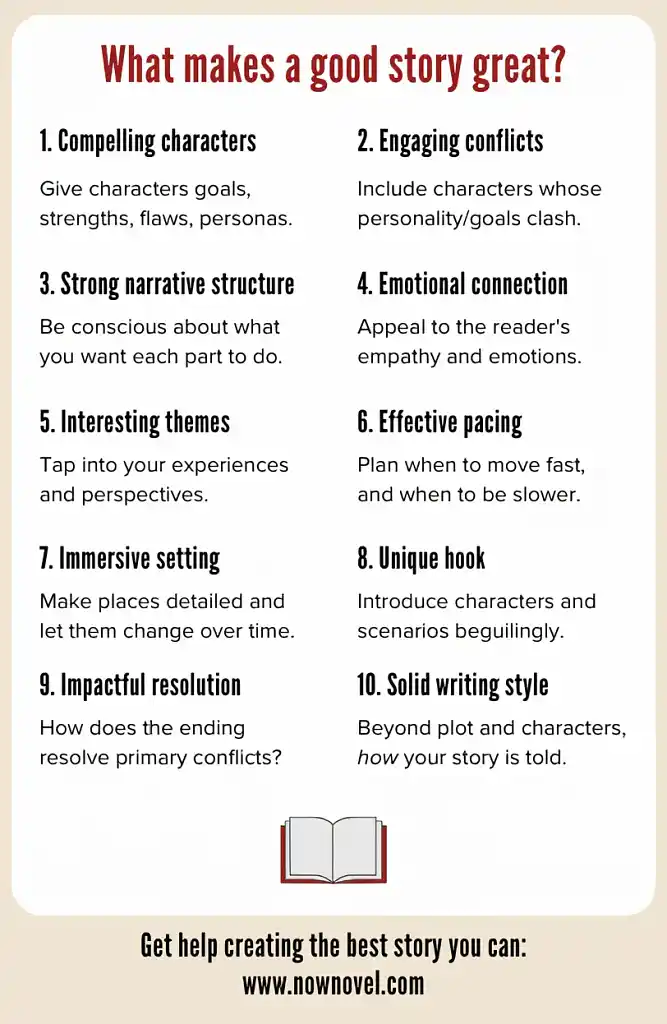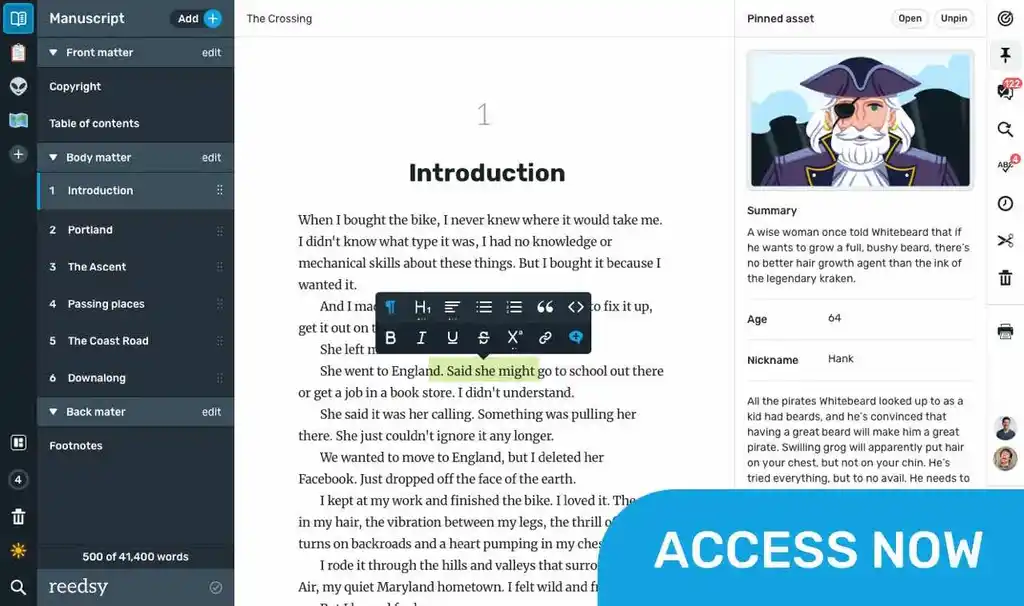What makes a good story? Think about how you choose between books in a bookstore. Elements like the cover and title might catch your eye — but anything you’ll want to read must hold your attention more substantially. If you’re not hooked within the first few pages, you’re unlikely to actually buy it.
So why do some books capture your attention while others lose it immediately? What separates a forgettable narrative from one that lingers in your mind for months, even years, after you’ve finished? In this post, we’ll break down the key elements that make a story work to help you write an amazing book.
What defines a good story?
A good story is one in which the plot, characters, and setting are a) individually well-developed, and b) tied together by the push-and-pull of conflict and, eventually, resolution.
This vivid and interesting setting, strong characters, and engaging plot need to interact in a way that captivates readers. Ideally, there will also be a well-constructed hook that sets this book apart from other stories. It’s a bonus if the characters, plot, or setting are particularly “fresh” — although relying on tried-and-true structures and archetypes can also work well, particularly in genre fiction.
If your story has these things, it will surely have a lasting impact beyond its final page, and may even make readers think, feel, or see the world differently after experiencing it. The more technical aspects of writing will remain important as well — but they take a backseat to the core elements of what makes your story work.
Speaking of which, let’s dive into exactly what those are.
1. Compelling characters
A great story is only as strong as its characters. Readers connect with books through the people in them, making well-developed and believable characters essential.
Characters' goals and motivations should be wholly their own and should help us understand their behaviour. With this in mind, ask yourself: what does each character in your book (even the secondary, 'walk on, walk off' ones) crave? Why do they want the things they do?
Example: Take Jay Gatsby from The Great Gatsby. His obsessive longing for Daisy is the driving force behind his actions and the novel’s central conflict. His external goal is to win Daisy back, but his internal struggle runs deeper: he wants to be the kind of man who never lost her in the first place. Yet his inability to see that the past is irretrievable ultimately leads to his downfall.
How to develop and refine your characters
- Don’t limit your characters to outward conflicts; draw on internal struggles that highlight their flaws as well.
- Tie your character's weaknesses and motivations to the key themes (see below for more advice on themes).
- Give your characters unique voices, personas, and expressions.
-
Utilize distinctive appearances (including body language, gait and mannerisms) to “show” the reader what a character is like.
![The Great Gatsby (2013) Image: Warner Bros.]()
The Great Gatsby (2013) is a great example of a dazzling facade hiding regret and corruption. Image: Warner Bros.
2. Engaging conflicts
When we read the word 'conflict' we often think immediately of actual violence. But there are many kinds of conflict, physical and otherwise, you can use to improve your story.
A character can face other characters of similar (or entirely opposite) personality. The characters could also face nature, society, and so on. Readers remain hooked when tension arises from varied sources and different story conflicts are combined within a single narrative.
Example: Hamlet by William Shakespeare thrives on layered conflicts, like Hamlet’s internal struggle with avenging his father, his external tension with Claudius, and the moral and existential questions that plague him. The stakes of justice, power, and Hamlet’s own sanity in these conflicts keep the audience captivated.
How to develop and refine your conflicts
- Create and bring together characters whose personalities clash.
- Write conflict that gives way to character transformation — good or bad.
- Combine different kinds of story conflicts within a single narrative. You can weave together internal and external conflicts, as mentioned above — but you can also combine conflicts like man vs. man and man vs. fate (as occurs in another Shakespearean tragedy, Macbeth).
3. Strong narrative structure
A compelling story needs a clear beginning, middle, and end — each serving a purpose in the reader’s journey. Traditionally, the beginning introduces characters and the main conflict, the middle deepens stakes and tension, and the ending provides a satisfying, tragic, or ambiguous resolution.
While sticking to the hero's journey is perfectly sensible, a more unusual narrative structure can potentially make your book successful.
Example: Gillian Flynn's Gone Girl alternates between the perspectives of Nick and Amy, gradually revealing hidden truths about their marriage. This dual narrative creates suspense, as readers are constantly re-evaluating their perceptions of each character. The eventual twists are both shocking in the moment and satisfying in retrospect because of the carefully calibrated structure.
How to develop and refine your narrative structure
- Outline your book, but don't let it become a cage — work around it and change it up as needed while your book idea matures and develops.
- Add subplots that supplement your main story arc and chosen themes.
- Show your characters’ true nature, including any hidden motivations, gradually over the course of the story; by the resolution, all should be revealed.
Free Course: How to Plot a Novel in 3 Acts
In 10 days, learn how to plot a novel that keeps readers hooked.
4. Emotional connection
A great story also resonates because it makes readers feel. It doesn't matter if it's joy, sadness, fear, or catharsis, as long as you manage to elicit a genuine response. Emotionally compelling stories also focus on characters’ desires, fears, and vulnerabilities, making their journeys relatable.
Example: The Fault in Our Stars by John Green is successful because it’s deeply emotional, tapping into universal themes of love, illness, and mortality. Hazel and Gus’s relationship is tender and tragic, mixing a nearly universal teenage love story with the extraordinary circumstances of cancer. It’s a prime setup for the cast of characters to display their vulnerabilities and be put under intense (but relatable) tension, making it easy for readers to connect with them.
How to develop and refine your story’s emotional connection
- Develop relatable, likeable characters — then give them an unpredictable and tight plot to navigate.
- Focus on making readers empathize with characters through authentic experiences and challenges.
- Avoid simply telling the reader how to feel; instead, show them what the characters are going through in emotional scenes where they struggle or break down.
Create vivid and believable characters facing relatable circumstances. It's not about the dragon to be slain; it's about the fear that it provokes and the bravery needed to do so.
5. Interesting themes
Themes add depth to a story by exploring bigger ideas beneath the plot. Common themes include fate vs. free will, real-world societal injustices, or the nature of love.
Don't be afraid of exploring something that might seem overdone at first; if you do it from a fresh perspective, it'll never be boring. Strong themes (or strong angles from which to explore them) give readers something to reflect on long after they finish the book.
Example: Never Let Me Go by Kazuo Ishiguro is an early example of a contemporary trend: exploring themes of identity, mortality, and ethical dilemmas through a seemingly quiet narrative that is actually much more complex (and unsettling) than its first impression implies.
How to develop and refine your themes
- Build a narrative on questions and motifs that resonate with you personally.
- Tap into your own experiences and perspective in order to develop these themes with greater depth.
- Use symbolism and motifs to frame the themes of a story — and add aesthetic and technical value to your novel as well.

6. Effective pacing
When a story is well-paced, it keeps readers engaged without rushing or dragging. Some sections may need fast pacing for action, while others require slower, reflective moments to build character depth. Aim to strike a balance that doesn't feel too dragged down, nor too relentless to allow readers to digest and reflect on the events of the story.
Example: In The Hunger Games, Suzanne Collins expertly controls pacing with short, tense sentences during action sequences and slower, introspective moments between battles. On a wider scale, the narrative starts off quiet and small as it portrays life in the dreary District 12, slowly raising the tension and having it explode as the games begin.
How to develop and refine your pacing
- Quicken the pacing and increase the tension with short sentences. Likewise, use longer sentences to help readers slow down and take a breath.
- Tap out the rhythm of your sentences' syllables every now and then, or read your prose aloud.
-
Avoid tiring readers with long-winded exposition dumps by strategically using short interjections of dialogue or action (meaning character actions — not necessarily high-octane chases and fights).
![The Hunger Games (2012) Image: Lionsgate Films]()
The Hunger Games (2012) opens with a slow, but tense, slice-of-life in District 12. Image: Lionsgate Films
7. Immersive setting
A strong setting transports readers, whether it’s a meticulously built fantasy world or a vividly described real-life location. A great setting feels lived-in and affects the characters' experiences.
Example: The wild and stormy Yorkshire moors of Wuthering Heights by Emily Brontë are more than just a backdrop: they reflect the passion, turmoil, and isolation of the novel’s characters. The untamed landscape and wild nature of the moors mirrors Heathcliff’s raw emotions and the way his vengeance strikes indiscriminately, making the setting a powerful metaphor that heightens (no pun intended) the rest of the story.
How to develop and refine your setting
- Make your setting feel more tangible by using sensory descriptions: the sight of a brightly colored storefront, the rumbling sound of cars passing, and so on.
- Force your characters to interact with the setting, and vice-versa. Sometimes the setting can “help” the characters along, whereas sometimes it will impede them.
- Contextualize the setting within a character's backstory. Remember that places change with time, just like characters do; you can use this passage of time to invoke emotionality, as discussed above.

Looking for a book coach?
Meet vetted book coaches who can help you turn your book idea into a reality.
8. A fresh or unique hook
A book needs something that grabs attention and promises something intriguing. You can achieve this through a unique premise outlined on the back cover, an unusual character as the protagonist, or a compelling question posed in the first few pages, to name a few strategies.
Example: The Girl with the Dragon Tattoo by Stieg Larsson. The novel’s hook is as follows: a disgraced journalist gets the chance to investigate a decades-old mystery — in exchange for information that could restore his credibility. This situation immediately sets up intrigue, high stakes, and unconventional dynamics.
How to develop and refine your hook
- Start your main story outline with a question. (In our example, this becomes: What if a hacker and a journalist teamed up to solve a murder?)
- Then branch out and plan twists that subvert some of the expectations you set up with the hook.
-
Cut extraneous information from the first part of your book — at this stage, you just need to grab readers’ attention, not bog them down with information.
![The Girl With The Dragon Tattoo (2011) hooks its main character the same way it hooks the audience. Image: Sony Pictures]()
The Girl with the Dragon Tattoo (2011) hooks its protagonist along with the audience. Image: Sony Pictures
9. Impactful resolution
A great ending doesn’t just conclude events; it leaves a lasting impression. Whether it’s a shocking twist, a satisfying resolution, or an open-ended conclusion, it should feel earned and make sense within the larger narrative.
Example: The ending of 1984 by George Orwell is bleak yet fitting, reinforcing the novel’s core theme of totalitarian control through the protagonist's defeat and submission to the regime. It lingers with readers, making them reflect on the story long after finishing.
How to develop and refine your ending
- Deploy the payoffs for all the foreshadowing and character arcs you've set up through the story.
- Ensure the outcome of your primary conflict feels explicable, but not predictable.
- With very few exceptions, avoid deus ex machina, a practically miraculous event that lets you tie things up quickly with little explanation. Characters developing amnesia in soap operas is a classic example of this.
10. Writing style
Finally, beyond plot and characters, how a story is told matters. A solid and distinctive writing style enhances immersion through poetic prose, witty dialogue, or a distinctive voice. You can bend the rules and be experimental, but it's important to master the rules before you break them!
Example: Cormac McCarthy’s The Road is told through sparse and unembellished prose that mirrors the bleak, post-apocalyptic world in which it's set. His stripped-down sentences, lack of punctuation (such as quotation marks), and rhythmic, almost biblical cadence create an atmosphere of desolation and raw survival. It highlights the narrator's detachment and worn-down feelings with every sentence.
How to develop and refine your style
- Read extensively to understand different styles, what resonates with readers, and what might fall flat.
- Try playing with different narrative voices — first person vs. third person, past tense vs. present, etc. — to find your style.
- Edit for clarity and flow — great style balances artistry with readability.
Remember, a great story is more than just an interesting premise or well-written prose — it’s an intricate combination of all the elements above and more. Learn how to outline and write an amazing story with constructive feedback from our writing coaches.















Late to the party, here but this is all solid stuff. It took me a minute to get the subplot thingy. Then I realized that few of us have solely one event going on in our lives at any given moment. It really helped me flesh-out ancillary characters from just "supporting" characters and/or sidekicks. Thanks for sharing.
Elias Mc Clellan - About 7 years ago
I'm glad to read this provided practical help for your WIP, thanks for sharing, Elias.
Jordan At Now Novel - Almost 7 years ago
Great Article eaadhar
Sk Nasim - Almost 7 years ago
The subplot and the settings is the things i dont have so i basically re-wrote everything
Likeable Kiwi - Over 5 years ago
Re-writing lets me polish things atleast
Likeable Kiwi - Over 5 years ago
That's true, Cjaye.
Jordan At Now Novel - Over 5 years ago
Indeed, it is a great one
Goldenseal - About 5 years ago
Thank you, Goldenseal. Happy 2021, may it bring inspiration.
Jordan - Almost 5 years ago
Wait, what about having a central theme?
Graphite - Almost 5 years ago
Hi Graphite, theme is more something that emerges out of the written story due to its subjects and the way they unfold. We tend to look for theme in the written work, as one of the ways of analysing and interpreting it (for example, Crime and Punishment by Dostoyevsky naturally has themes around justice and criminality due to its subjects). Yet theme isn't necessarily something an author consciously works into their story, it depends on the author. I hope this is helpful.
Jordan - Almost 5 years ago
The theme is therefore an important part but not something an author would work consciously on? Well... I do prefer a sort of theme (not exactly a moral) in a story so that I don't just write about many things that would then confuse the reader.
Graphite - Almost 5 years ago
Hi Graphite, thank you for sharing your thoughts about themes. Would you say you use theme then as a means for guiding the story itself? Often we interpret and identify themes in a written work after the fact, but I imagine many writers are also conscious of their own themes and concsciously/actively draw them out. It all depends on how you like to work and whether theme is something you keep in mind or allow to emerge out of grappling with particular subjects and scenarios.
Jordan - Almost 5 years ago
When was this published?
Pippa - Almost 5 years ago
Hi Pippa, thank you for asking. The first version was published August 9th 2018.
Jordan - Almost 5 years ago
I wrote a story a while ago that involved many of the elements mentioned above. However, when I read this article I found out that there is more to story writing than what I perceived. This will differently help me sharpen my story writing skills thank you.
Fahad - Over 4 years ago
Hi, Fahad! Thank you for your feedback, good luck with the sharpening.
Jordan - Over 4 years ago
Hi, thank you very much for both this article and also other articles in this site. I realize that I'm no master in prose, especially after seeing these brilliant articles. I wanted to ask, what if my story rolls out in a slow pace? I planned to make five chapters that all occured through the first day of school, and my ensemble cast hasn't really interacted much there. However, I do tease a lot about the true protagonist's personal turmoil, and her fears do show through that unexpected day. How can I make these first 5 chapters not boring for the readers?
Karen - Over 4 years ago
Hi Karen, thank you for your kind words and for reading our blog! Everyone starts somewhere (I'm certainly no master myself!). I would suggest seeing whether you could condense the first five chapters down to perhaps one, two maximum spanning the first day of school, giving a glimpse of the protagonist's turmoil over a shorter span of the opening. Ideally the inciting incident (the event that sets the story in motion and suggests what key conflicts could be) will occur within the first chapter or two. Delay it further and you're correct in thinking the reader could possibly get a little frustrated. Once that information is given, one can start building forward momentum sooner. If you'd like feedback on your story beginning, please feel free to submit it for feedback in our online writing groups, you'll find a constructive and encouraging bunch there. Good luck!
Jordan - Over 4 years ago
I completely agree with what you have written. I hope this post could reach more people as this was truly an interesting post.
Wayne Scott Harral - Over 4 years ago
Thank you for your kind feedback, Wayne. Thanks for reading our blog.
Jordan - Over 4 years ago
I find this information very helpful because I'm learning about novels, rhyme, dialogue and climax
Sam - Over 3 years ago
I'm glad to hear that, Sam. What are you working on currently yourself? Thank you for reading our blog.
Jordan - Over 3 years ago
This is so amazing. I can make my story more alive and Interesting to read.
Rem - Almost 3 years ago
Hi Rem, thank you for your kind feedback, here's to a great 2023 for your writing.
Jordan - Almost 3 years ago
Please what about the fantasy part, how can i make it really engaging to readers
Jameson Jax - Almost 3 years ago
Hi Jameson, thank you for your question and for reading our blog. We have a complete guide to fantasy here that I hope you'll find helpful! If you have any questions about fantasy that article doesn't answer, please do share in the comments.
Jordan - Almost 3 years ago
A most helpful post. It will help me in my current WIP in which I am a little stuck at the moment.
V.M. Sang - Almost 2 years ago
Dear VM Sang, that's great to know. Hope it helps you and you make good progress with your writing.
Arja Salafranca - Almost 2 years ago